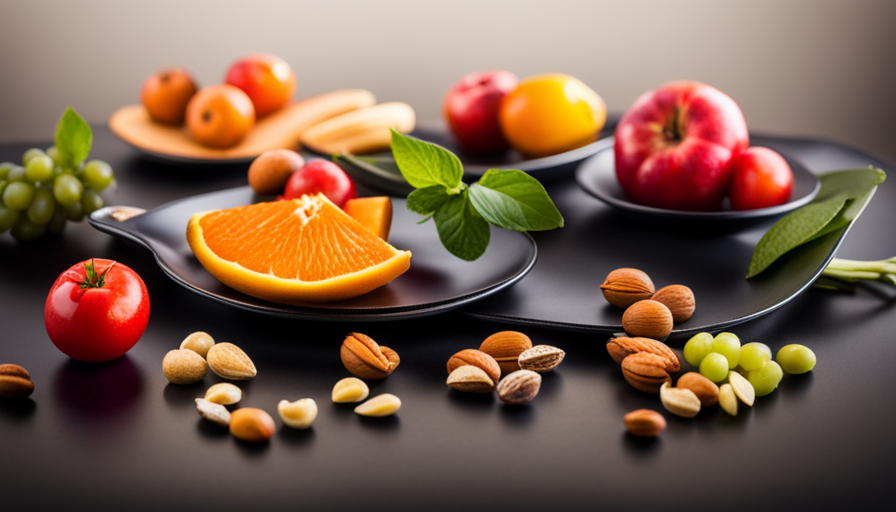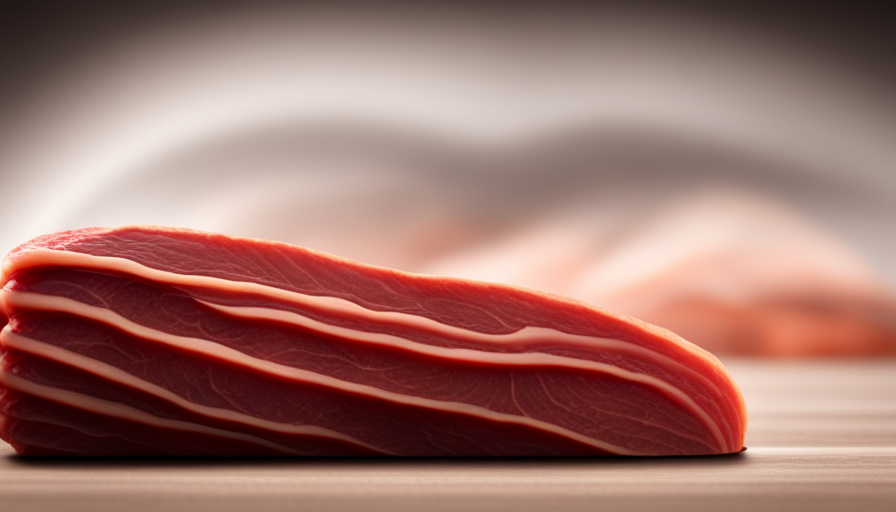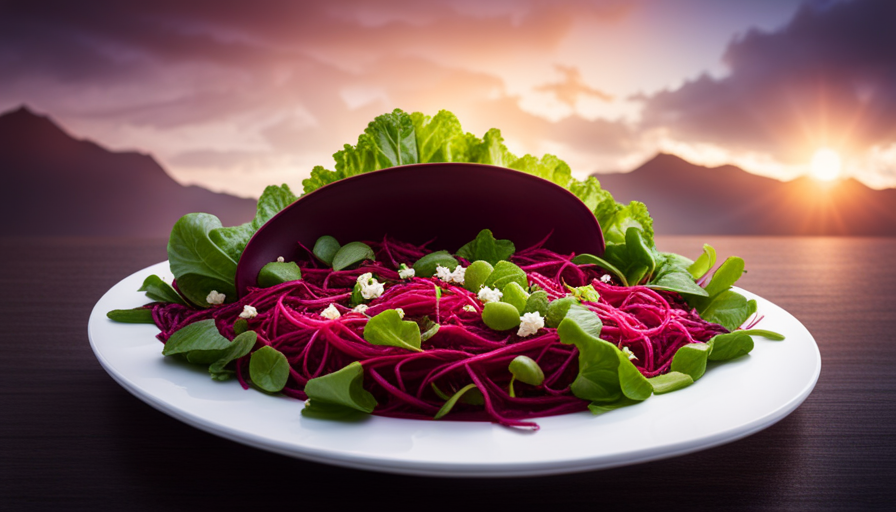I recently discovered an intriguing case study that piqued my curiosity about the raw food diet. A woman named Sarah had been dealing with chronic fatigue and digestive problems for years, experimenting with various diets and medications without much success. In search of a solution, she opted to experiment with the raw food diet. In a matter of weeks, Sarah experienced a significant boost in her energy levels and digestive health.
This got me wondering, what exactly is the raw food diet and could it have similar benefits for others?
In this article, we will delve into the world of the raw food diet, exploring its potential benefits, considerations before starting, and how to successfully transition to this lifestyle. We will also debunk common myths and misconceptions surrounding this diet, as well as discuss its potential use for specific health conditions.
If you’ve ever been curious about the raw food diet and whether it’s right for you, keep reading to find out more.
Key Takeaways
- Raw food diet is based on consuming unprocessed, uncooked, organic foods such as fruits, vegetables, nuts, seeds, and sprouted grains.
- It is believed to have potential benefits such as increased energy, improved digestion, weight loss, clearer skin, and boosted immune system.
- Transitioning to a raw food diet requires careful planning and consideration, with a gradual transition recommended for the body to adjust.
- Meal planning and recipe ideas are essential for meeting nutritional needs and overcoming cravings, with a focus on nutrient-dense raw foods for vitamins, minerals, and enzymes.
What is the Raw Food Diet?
Are you curious about the raw food diet and what it actually entails? Well, let me break it down for you. The raw food diet is a dietary approach that emphasizes the consumption of unprocessed, uncooked, and mostly organic foods.
This diet typically includes fruits, vegetables, nuts, seeds, and sprouted grains. The idea behind this diet is that cooking and processing foods can destroy their natural enzymes and nutrients, so by eating them raw, you can maximize their nutritional value.
While the raw food diet has its potential health benefits, such as increased energy levels, improved digestion, and weight loss, it also has some potential drawbacks.
One of the main concerns is the risk of nutrient deficiencies, particularly in vitamin B12, iron, calcium, and omega-3 fatty acids. Additionally, some people may find it challenging to meet their calorie needs on a raw food diet, which can result in weight loss or inadequate energy levels.
Despite these potential drawbacks, many individuals have reported positive outcomes from following the raw food diet. In the next section, we will explore the potential benefits of this diet and how it can improve overall health and well-being.
So, let’s dive into the potential benefits of the raw food diet and discover how it can positively impact your life.
Potential Benefits of the Raw Food Diet
One potential benefit of adopting a raw food lifestyle is that it can be a breath of fresh air for your body, like a cool breeze on a warm summer day. While scientific evidence is limited, some individuals report experiencing positive changes in their health and well-being when following the raw food diet. Here are five potential benefits that may evoke an emotional response in you:
-
Increased energy levels: Many raw food enthusiasts claim to feel more energized and alert throughout the day.
-
Improved digestion: Raw fruits and vegetables are rich in fiber, which can support a healthy digestive system.
-
Enhanced weight management: The raw food diet is often associated with weight loss due to its emphasis on whole, unprocessed foods.
-
Clearer skin: Some people have reported improvements in their skin’s appearance, attributing it to the high intake of water-rich fruits and vegetables.
-
Boosted immune system: Raw foods are packed with essential nutrients and antioxidants that may support a stronger immune system.
While these potential benefits are intriguing, it’s important to note that there are also potential drawbacks to consider. Additionally, the scientific evidence supporting the raw food diet’s effectiveness is limited. Transitioning to a raw food lifestyle requires careful consideration and planning to ensure you meet all your nutritional needs.
Considerations Before Starting the Raw Food Diet
Before diving into the world of raw food, it’s crucial to consider a few key factors. One important aspect to think about is the gradual transition to a raw food diet. Suddenly switching from a diet filled with cooked and processed foods to one that consists solely of raw fruits, vegetables, nuts, and seeds can be a shock to your system. It’s recommended to start by incorporating more raw foods into your meals gradually, allowing your body to adjust to the change.
Another consideration is meal planning. The raw food diet requires careful planning to ensure you’re getting all the necessary nutrients. It’s important to include a variety of fruits, vegetables, nuts, and seeds to ensure you’re getting a balanced diet. Meal prepping and having a well-stocked kitchen with fresh produce and raw food essentials can make the transition easier.
Transitioning to a raw food diet requires thoughtful consideration and planning. By gradually incorporating more raw foods into your meals and carefully planning your meals, you can set yourself up for success on this dietary journey.
The next section will delve into the specific steps you can take to transition to a raw food diet seamlessly.
How to Transition to a Raw Food Diet
When transitioning to a raw food diet, there are a few key points to consider.
First, you have the option of a gradual or immediate transition. Gradual transitions allow your body to adjust slowly, while immediate transitions can provide quick results.
Second, meal planning and recipe ideas are essential to ensure you’re getting a variety of nutrients and flavors.
Lastly, overcoming cravings and food addiction can be challenging, but with determination and support, it’s possible to develop a healthier relationship with food.
Gradual vs. immediate transition
If you’re looking to dip your toes into the raw food diet, transitioning gradually is like wading into a refreshing pool, while jumping in immediately is like diving headfirst into a thrilling adventure. Both approaches have their benefits and considerations.
Gradual transition allows your body to adjust slowly to the new diet, minimizing potential detoxification symptoms and making it easier to stick with the changes. You can start by incorporating more raw fruits, vegetables, and nuts into your meals while gradually reducing cooked and processed foods.
On the other hand, an immediate transition can provide a sense of excitement and commitment to the raw food diet. It requires a strong dedication and willingness to adapt quickly to a new way of eating.
Ultimately, the choice between gradual and immediate transition depends on your personal preferences, health status, and readiness for change.
Now, let’s move on to exploring meal planning and recipe ideas for the raw food diet.
Meal planning and recipe ideas
To make your transition to a raw food lifestyle more enjoyable, let’s dive into the world of delicious meal planning and tantalizing recipe ideas. Meal prep is an essential part of successfully following a raw food diet. By planning your meals ahead of time, you can ensure that you have all the necessary ingredients on hand and avoid the temptation of reaching for unhealthy options. When it comes to ingredient sourcing, it’s important to choose fresh, organic produce to maximize the nutritional value of your meals. To help you get started, here are some recipe ideas that are both nutritious and flavorful:
| Breakfast | Lunch | Dinner |
|---|---|---|
| Green smoothie | Raw salad | Zucchini noodles |
| Chia pudding | Raw wraps | Raw pad thai |
| Fruit salad | Raw soup | Veggie sushi rolls |
By incorporating these meals into your weekly menu, you’ll be well on your way to enjoying the benefits of a raw food lifestyle. Now, let’s explore how to overcome cravings and food addiction.
Overcoming cravings and food addiction
Overcoming cravings and food addiction can be a challenging journey, but with determination and support, you can break free from unhealthy eating patterns and embrace a more nourishing lifestyle.
Cravings often stem from emotional eating, where we use food to cope with stress, sadness, or boredom. Identifying triggers and finding healthier alternatives like engaging in physical activity, practicing mindfulness, or seeking emotional support can help overcome these cravings.
It’s important to remember that cravings are temporary and can be managed by focusing on nutrient-dense raw foods that provide the necessary vitamins, minerals, and enzymes. Gradually incorporating more raw fruits, vegetables, nuts, and seeds into your diet can help satisfy cravings while promoting overall wellness.
Transitioning into the subsequent section about common myths and misconceptions about the raw food diet, it’s essential to separate fact from fiction to make informed decisions about this dietary approach.
Common Myths and Misconceptions About the Raw Food Diet
Don’t let the common myths and misconceptions about the raw food diet cloud your judgment – it’s time to clear the plate and embrace the true potential of this nourishing lifestyle. Many people believe that the raw food diet is time-consuming and difficult when it comes to meal preparation. However, with a little planning and creativity, it can actually be quite simple and enjoyable. There are countless delicious raw food recipes available that require minimal preparation and offer maximum flavor and nutrition.
Another common myth is that the raw food diet is lacking in essential nutrients. However, when properly planned, this diet can provide all the necessary nutrients for a healthy body. It is important to include a variety of fruits, vegetables, nuts, seeds, and sprouted grains to ensure a well-rounded diet.
To debunk these myths and misconceptions, let’s take a look at the following table:
| Myth | Reality |
|---|---|
| Raw food diet is time-consuming | With proper planning, it can be simple and enjoyable |
| Raw food diet is lacking in essential nutrients | Properly planned, it can provide all necessary nutrients |
By understanding the reality behind these myths, we can see that the raw food diet is a viable and nourishing lifestyle choice. However, it is important to be aware of potential health risks and side effects, which will be discussed in the next section. Transitioning into the next topic, we need to consider the potential risks and side effects of the raw food diet.
Potential Risks and Side Effects of the Raw Food Diet
When considering the potential risks and side effects of the raw food diet, it’s important to be aware of the potential for nutritional deficiencies and imbalances. This diet restricts the consumption of cooked and processed foods, so it may be challenging to obtain all the necessary nutrients, such as vitamin B12 and iron.
Additionally, digestive issues and bloating may occur due to the high fiber content and raw nature of the foods consumed.
Lastly, following a raw food diet may lead to limited food choices and social restrictions, as it can be difficult to find raw options when dining out or attending social gatherings.
Nutritional deficiencies and imbalances
One potential drawback of the raw food diet is that it can lead to significant nutritional deficiencies and imbalances. While the diet emphasizes consuming fruits, vegetables, nuts, and seeds in their raw and natural form, it may not provide all the essential nutrients our bodies need.
Some potential nutritional deficiencies and imbalances that can occur include:
- Vitamin B12 deficiency, as this vitamin is primarily found in animal products.
- Iron deficiency, as the body absorbs iron more efficiently from cooked foods.
- Calcium deficiency, as raw plant foods may not provide sufficient amounts of this mineral.
- Omega-3 fatty acid imbalance, as the diet may not provide enough of the essential fatty acids found in fish and seafood.
- Protein deficiency, as plant-based proteins may not be as easily absorbed or complete as those from animal sources.
These nutritional deficiencies and imbalances can have negative impacts on our health and wellbeing.
Transitioning to the next section, digestive issues and bloating can also be a concern when following the raw food diet.
Digestive issues and bloating
Now, let’s talk about another potential issue when following a raw food diet: digestive issues and bloating. It’s important to note that while a raw food diet can be rich in fiber, essential nutrients, and enzymes, it can also be challenging for some individuals to digest.
This is because raw foods can be more difficult for the body to break down compared to cooked foods. As a result, some people may experience bloating, gas, and discomfort after meals. Causes of bloating on a raw food diet can vary and may include factors such as excessive intake of raw cruciferous vegetables, legumes, or fruits high in fructose.
Additionally, inadequate chewing and eating too quickly can also contribute to digestive issues. Understanding these potential challenges can help individuals make informed decisions about their dietary choices.
Moving forward, we will explore another aspect of the raw food diet: limited food choices and social restrictions.
Limited food choices and social restrictions
The raw food lifestyle presents individuals with a somewhat limited array of culinary options and can impose certain social constraints.
-
Limited food choices: The raw food diet primarily consists of uncooked fruits, vegetables, nuts, and seeds. This limits the variety of foods available compared to a traditional cooked diet.
-
Social restrictions: Following a raw food diet may make it challenging to eat out or attend social events that revolve around cooked meals. It can also be difficult to find suitable options when dining with friends or family who don’t follow the same dietary choices.
-
Cultural differences: Different cultures may have a limited selection of raw food dishes, making it harder for individuals to adhere to the raw food lifestyle.
-
Potential isolation: The limited food choices and social restrictions may lead to feelings of isolation or exclusion from mainstream food practices.
Transition: Despite the challenges, the raw food diet can be tailored to specific health conditions, as discussed in the next section.
Raw Food Diet for Specific Health Conditions
If you’re looking to improve your health conditions, the raw food diet might be worth considering. This diet has gained popularity for its potential benefits in weight loss and diabetes management. By consuming primarily raw fruits, vegetables, nuts, and seeds, individuals following this diet aim to optimize nutrient intake while avoiding processed foods.
For weight loss, the raw food diet can be effective due to its low calorie and high fiber content. Fruits and vegetables are naturally low in calories and high in fiber, which can promote feelings of fullness and reduce overall calorie intake. Additionally, the diet’s emphasis on whole, unprocessed foods can lead to a reduced intake of unhealthy fats and added sugars.
When it comes to diabetes management, the raw food diet can help regulate blood sugar levels. By avoiding high-glycemic foods like refined grains and sugars, individuals can prevent spikes in blood glucose levels. The diet’s focus on whole, plant-based foods can also improve insulin sensitivity and promote weight loss, both of which are beneficial for diabetes management.
To illustrate the potential benefits of the raw food diet for weight loss and diabetes management, here is a comparison table:
| Raw Food Diet for Weight Loss | Raw Food Diet for Diabetes Management |
|---|---|
| Low in calories | Low glycemic index |
| High in fiber | Promotes weight loss |
| Avoids processed foods | Improves insulin sensitivity |
Considering these potential benefits, the raw food diet can be a promising approach for individuals looking to improve their health conditions. In the next section, I will provide some tips for success on the raw food diet, which can help you achieve your health goals without feeling deprived or restricted.
Tips for Success on the Raw Food Diet
To make the most of your raw food journey, imagine yourself as a skilled chef, effortlessly creating vibrant and nutrient-packed meals that nourish your body like a symphony of flavors. Transitioning to a raw food diet can be a gradual process, allowing your body to adjust to the changes.
Here are three tips to help you succeed on the raw food diet:
-
Gradual Transition: Instead of diving headfirst into a completely raw diet, start by incorporating more raw fruits, vegetables, and nuts into your meals. Gradually increase the raw portion of your diet while reducing cooked and processed foods. This approach can make the transition easier and more sustainable.
-
Meal Planning: Planning your meals in advance can be incredibly helpful on a raw food diet. Ensure you have a variety of fruits, vegetables, nuts, and seeds on hand to create balanced meals. Experiment with different flavors, textures, and combinations to keep your meals exciting and enjoyable.
-
Get Creative: Embrace the creativity that comes with raw food preparation. Explore different techniques like sprouting, fermenting, and dehydrating to add variety to your meals. Try new recipes, experiment with different seasonings, and don’t be afraid to think outside the box.
By gradually transitioning and incorporating meal planning into your raw food journey, you can set yourself up for success. Now let’s delve into some frequently asked questions about the raw food diet.
Frequently Asked Questions About the Raw Food Diet
Can you eat cooked foods occasionally on the raw food diet? According to the experts, occasional consumption of cooked foods is generally accepted in the raw food diet community. However, it’s important to note that the majority of your diet should still consist of raw, unprocessed foods in order to reap the full benefits of this lifestyle.
Can you get enough protein on a raw food diet? Many people have concerns about protein intake on a raw food diet, but it’s entirely possible to meet your protein needs through plant-based sources. Foods like nuts, seeds, legumes, and leafy greens can provide ample amounts of protein to support a healthy diet.
Can children and pregnant women follow the raw food diet? While the raw food diet can be a healthy choice for adults, it may not be suitable for children and pregnant women. These groups have specific nutrient requirements that may be challenging to meet solely through a raw food diet. It’s important to consult with a healthcare professional before making any significant dietary changes.
Can you eat cooked foods occasionally?
Although the raw food diet promotes primarily uncooked foods, cooked options can be enjoyed occasionally. The cooked vs raw food debate is a topic of discussion within the raw food community. While raw food enthusiasts believe that cooking destroys vital nutrients and enzymes in food, others argue that cooking can enhance nutrient availability and digestion.
However, there are potential health benefits to incorporating cooked foods occasionally. Cooking certain vegetables, such as tomatoes and carrots, can actually increase the bioavailability of certain nutrients like lycopene and beta-carotene. Additionally, cooking can make some foods easier to digest, especially for individuals with digestive issues.
It is important to note that cooking methods that preserve nutrients, such as steaming or lightly sautéing, are preferred over deep-frying or high-temperature cooking.
Transitioning into the subsequent section about ‘can you get enough protein on a raw food diet?’, it is crucial to consider the nutritional aspects of a raw food diet.
Can you get enough protein on a raw food diet?
Yes, you can occasionally eat cooked foods while following a raw food diet. However, the key is to keep the majority of your diet raw to maximize the benefits of this lifestyle.
Now, let’s address the concern of protein on a raw food diet. While it’s true that many common protein sources such as meat and dairy are eliminated, there are still plenty of plant-based protein options available. These include nuts, seeds, legumes, and certain vegetables like spinach and broccoli.
It’s important to note that protein requirements can vary depending on factors such as age, sex, and activity level. However, by incorporating a variety of protein-rich foods into your raw food diet, it’s possible to meet your protein needs.
Now, let’s explore whether children and pregnant women can follow the raw food diet.
Can children and pregnant women follow the raw food diet?
Children and pregnant women may find it beneficial to explore the suitability of a raw food lifestyle. However, it’s important to approach this diet with caution, as it may be challenging to meet the nutritional needs of these specific groups.
For children, a raw food diet can potentially limit important nutrients needed for proper growth and development, such as protein, iron, and calcium. It’s crucial to ensure that children on a raw food diet receive adequate amounts of these nutrients through other sources.
Additionally, pregnant women should be mindful of their nutrient intake, especially during this crucial period of fetal development. It’s essential to consult with a healthcare professional to ensure that both the mother and baby receive sufficient nutrients, including protein, omega-3 fatty acids, and vitamins.
Breastfeeding mothers should also be cautious, as a raw food diet may impact milk production and quality.
Considering these factors, it’s important to weigh the potential benefits and risks before deciding if the raw food diet is suitable for children and pregnant women.
In the next section, we’ll discuss the overall conclusion: is the raw food diet right for you?
Conclusion: Is the Raw Food Diet Right for You?
When considering whether the raw food diet is right for me, there are a few key points I need to consider. First and foremost, I need to take into account my personal considerations and goals. It’s important to understand what I hope to achieve by following this diet and whether it aligns with my lifestyle and preferences.
Additionally, consulting with a healthcare professional is crucial in order to ensure that I’m meeting all of my nutritional needs and to address any potential health concerns.
Lastly, finding a balanced approach to nutrition and wellness is essential. It’s important to remember that no single diet is a one-size-fits-all solution, and it’s important to find a way to incorporate the principles of the raw food diet into a well-rounded and sustainable approach to overall health and well-being.
Personal considerations and goals
Although the raw food diet can be challenging to follow, I believe that it can be a beneficial option for individuals who prioritize their health and have specific dietary goals.
Personal reflection is essential when considering this lifestyle change, as it requires a strong commitment to consuming uncooked and unprocessed foods.
It is important to consider long-term sustainability and whether this way of eating aligns with your personal values and preferences.
Additionally, it is crucial to consult with a healthcare professional before embarking on this diet to ensure that it meets your nutritional needs and doesn’t pose any risks to your health.
Seeking guidance from a professional can provide valuable insights and help you make an informed decision about whether the raw food diet is right for you.
Consulting with a healthcare professional
Seeking guidance from a healthcare professional can paint a clearer picture of the potential benefits and risks associated with incorporating uncooked and unprocessed foods into your lifestyle. Consulting with a healthcare professional can provide valuable insights into the specific nutrient requirements of your body and help determine if the raw food diet is suitable for you.
Here are a few reasons why consulting with a healthcare professional is important:
-
Personalized advice: A healthcare professional can assess your individual health needs and provide personalized recommendations to ensure you’re meeting your nutritional requirements.
-
Monitoring health markers: Regular check-ups and monitoring of health markers can help identify any potential deficiencies or imbalances that may arise from following a raw food diet.
-
Managing potential risks: Consulting with a healthcare professional can help you understand and manage any potential risks associated with the raw food diet, such as foodborne illnesses or nutrient deficiencies.
By consulting with a healthcare professional, you can make informed decisions about your dietary choices and find a balanced approach to nutrition and wellness.
Finding a balanced approach to nutrition and wellness
Finding a balanced approach to nutrition and wellness is crucial for achieving optimum health and vitality. When following a raw food diet, it’s important to ensure that you’re getting all the necessary nutrients your body needs.
While raw foods can provide many benefits such as increased energy and improved digestion, it’s essential to include a variety of foods to ensure a well-rounded and balanced diet. Incorporating a mix of fruits, vegetables, nuts, seeds, and grains can help provide the necessary vitamins, minerals, and antioxidants that promote holistic wellness.
It’s also important to consult with a healthcare professional to ensure that you’re meeting your nutritional needs and to address any potential deficiencies that may arise from following a raw food diet.
By finding a balanced approach to nutrition and wellness, you can support your overall health and well-being.
Frequently Asked Questions
Can children follow a raw food diet?
As a parent, I understand the desire to provide the healthiest diet for our children. However, following a raw food diet can present challenges for children. While it can provide valuable nutrients, it may lack certain essential nutrients like iron, calcium, and vitamin B12, which are crucial for their growth and development.
It’s important to consult with a healthcare professional before making any dietary changes for children to ensure they receive all the necessary nutrients.
Is it necessary to eat exclusively raw food on the raw food diet?
It is not necessary to eat exclusively raw food on the raw food diet. While the diet emphasizes the consumption of raw, unprocessed, and uncooked foods, it doesn’t require complete exclusivity.
Some individuals choose to incorporate cooked foods into their diet while still adhering to the principles of the raw food diet. However, it’s important to note that certain foods, such as grains, legumes, and dairy products, are typically restricted on the raw food diet.
Can the raw food diet provide all the necessary nutrients for optimal health?
The raw food diet can provide all the necessary nutrients for optimal health if it’s well-planned. However, there is a risk of nutrient deficiencies due to the limited variety of foods consumed. It’s important to ensure adequate intake of essential nutrients like protein, calcium, iron, and vitamin B12, which are commonly found in animal-based foods. Including a wide range of raw fruits, vegetables, nuts, and seeds can help meet these nutrient needs and maintain a balanced diet.
How does the raw food diet affect digestion and bowel movements?
The raw food diet can have digestive benefits and promote gut health. Consuming raw fruits, vegetables, nuts, and seeds can provide a good amount of fiber, which aids digestion and promotes regular bowel movements.
The enzymes present in raw foods can also aid in the breakdown of nutrients, improving digestion. However, it’s important to note that some people may experience difficulty digesting certain raw foods, such as legumes or cruciferous vegetables.
It’s always best to listen to your body and make sure you’re getting all the necessary nutrients for optimal health.
Is it possible to gain weight on the raw food diet?
Yes, it’s possible to gain weight on the raw food diet. While this diet is often associated with weight loss, it’s still possible to consume a surplus of calories from high-fat nuts, seeds, and oils. To gain weight on this diet, you would need to consume more calories than you burn through physical activity. It’s important to maintain a balanced approach and consult with a healthcare professional for personalized guidance.
What Are the Potential Benefits of Following a Raw Food Diet?
Following a raw food diet can lead to numerous benefits. The results of raw food diet may include improved digestion, increased energy levels, better skin health, and weight loss. Additionally, it may reduce the risk of certain health conditions and provide a higher intake of essential nutrients.
Conclusion
In conclusion, after exploring the raw food diet, I’ve found that it can offer numerous health benefits. These include increased energy and weight loss. However, it’s important to consider the potential challenges and limitations of this diet before deciding to try it.
Transitioning to a raw food diet requires careful planning and consideration of individual nutritional needs. It’s crucial to debunk common myths and misconceptions surrounding this diet.
Is the raw food diet the right choice for you? Only you can decide based on your own research and consultation with a healthcare professional.










